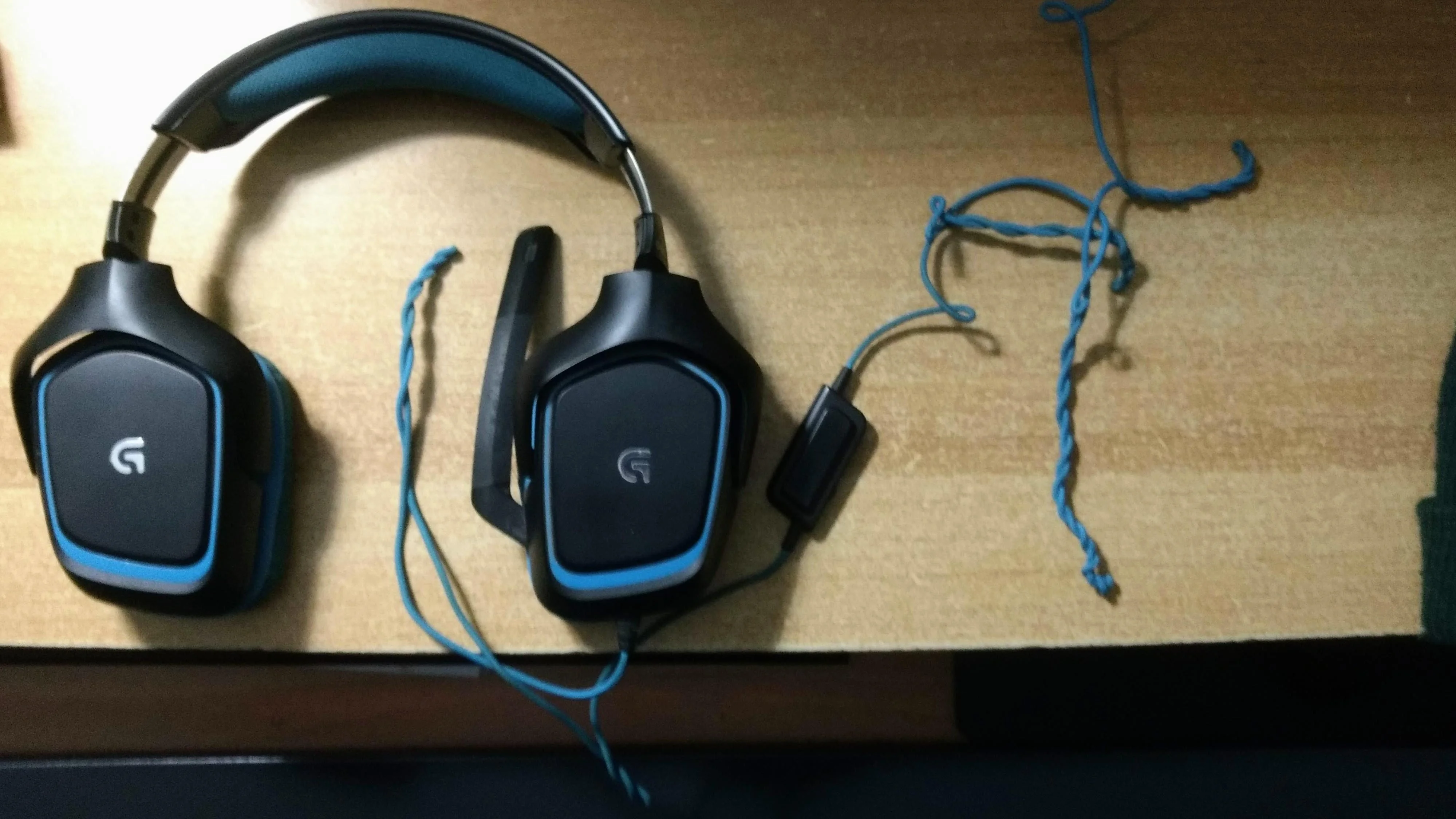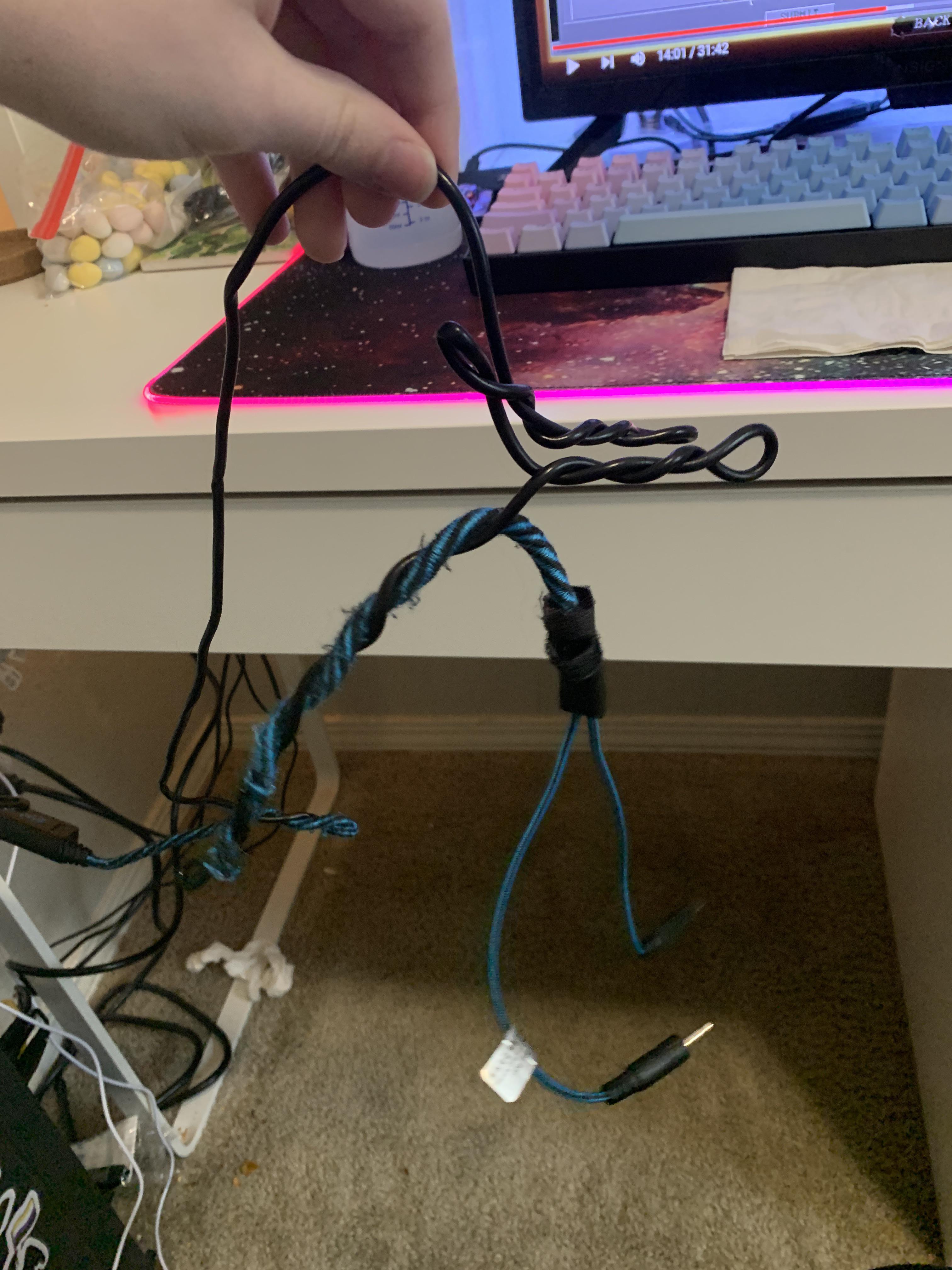How To Stop Headphone Wires From Curling?
How to stop headphone wires from curling? If you're tired of constantly dealing with tangled and coiled headphone wires, you're not alone. The frustration of having to unravel your headphones every time you want to use them can be a thing of the past.
Author:Anderson PattersonReviewer:Elisa MuellerNov 15, 2023952 Shares317.4K Views

How to stop headphone wires from curling? If you're tired of constantly dealing with tangled and coiled headphone wires, you're not alone. The frustration of having to unravel your headphones every time you want to use them can be a thing of the past.
In this guide, we will explore practical techniques to prevent your headphone wires from curling and tangling, ultimately extending the lifespan of your beloved audio gear. Say goodbye to those frustrating knots, and enjoy a seamless listening experience.
Causes Of Headphones Curling
Cords and cables consist of various materials, including metal cable strands, plastic and rubber insulation, and other inner components. These materials have distinct compositions and varying degrees of flexibility, which can lead to bending at different rates.
In addition, most cords are inherently loose, flexible, and lack external support, making them prone to twisting and coiling if left unattended. Due to their often considerable length, these cords tend to become entangled with themselves, and it can be said that tangling is the default behavior of any cable or cord.
Understanding Cable Composition
- Metal Cable Strands:The conductive core of most cables is made up of multiple metal strands, typically copper or aluminum. These strands are responsible for carrying the electrical signals.
- Plastic and Rubber Insulation:Surrounding the metal strands, cables are insulated with materials like plastic and rubber. This insulation not only protects the wires but also plays a role in maintaining the overall flexibility of the cable.
- Filling Materials:Some cables may contain additional filling materials to enhance durability and resistance to wear and tear.
The Physics Of Cord Tangles
The nature of cable materials and design leads to the common phenomenon of cord tangling:
- Differential Bending:Each component of the cable, including the metal strands and insulation, has its own level of flexibility. As a result, they tend to bend at different rates when subjected to twists or turns.
- Lack of Support:Most cables are unstructured and unsecured, which means they lack support to maintain a specific form or direction. This makes them highly susceptible to coiling and tangling.
- Tangling Propensity:Given these factors, the default behavior of a cable is to become tangled. The inherent flexibility of the cable components combined with the absence of external support creates an environment conducive to tangling.
Practical Implications
Tangled cords not only cause inconvenience but can also lead to wear and damage over time. Tension from knots and kinks can weaken the structural integrity of the cable, potentially affecting its functionality.
In response to this common issue, various methods, such as cable management tools, cord organizers, and coiling techniques, have been developed to mitigate tangling and maintain the integrity of cords and cables.
These strategies help users keep their cables in an organized and untangled state, extending the lifespan of their devices and ensuring uninterrupted performance.
How To Stop Headphone Wires From Curling
Dealing with tangled headphone wires can be an exasperating issue that plagues many headphone users. Twisted and knotted cords not only hinder your listening experience but also contribute to the wear and tear of your headphones. Constantly wrestling with tangled wires can lead to frustration and, over time, may even cause damage to the cords.
Deciphering The Conundrum Of Tangling
The coiling or tangling of headphone wires arises from the inherent flexibility and elasticity of these cords. Most headphone cables are crafted from materials like rubber or plastic, which possess a certain level of elasticity.
When the cord is bent or twisted, it stores potential energy. Upon release, this energy drives the cord to revert to its original shape, often resulting in twirls and coils.
Additionally, the way headphones are commonly stored or used can exacerbate tangling issues. Haphazard coiling and tight winding of wires around devices can lead to kinks and twists in the cord, making it more susceptible to tangling.
Embrace The Over-Under Wrapping Technique
One effective strategy to prevent headphone wires from tangling is the over-under wrapping technique, also known as the "professional wrap." To apply this technique, grasp the earbuds in one hand and the jack in the other.
Initiate by forming a small loop with the cord, crossing it over itself. Subsequently, loop the cord under the first loop, creating a pattern of alternating over and under loops. This method ensures that the cord remains free from twisting or coiling upon storage and use, significantly reducing tangling issues.
Leverage Cable Winders
Cable winders, purpose-built accessories, are designed to keep headphone wires well-organized and thwart tangling. These winders are available in various sizes and designs, ranging from compact, portable versions to more elaborate desktop models.
Cord winders allow you to neatly wind the headphone wire around a central spindle, ensuring it stays straight and free from twists when not in use. The use of cable winders not only preserves the longevity of your headphone cords but also spares you the exasperation of untangling knotted wires.
Employ Cord Clips
Cord clips present yet another pragmatic solution to ward off tangling of headphone wires. Available in various designs, cord clips enable you to secure the cord to your attire, bag, or desk.
By utilizing cord clips, you keep the headphone wire in place during movement, reducing the likelihood of tangling during use. These clips prove especially beneficial during physical activities or while you're on the move.
Steer Clear Of Tight Coiling
A common mistake that contributes to headphone wire tangling is tightly coiling the cords around devices or your hand. When winding the cords for storage, exercise gentle care and abstain from forming tight loops.
Instead, adopt the aforementioned over-under wrapping technique, which maintains a more organized and untangled cord. Eschewing tight coiling not only averts tangling but also minimizes stress and strain on the cord, thereby extending its lifespan.
Establish A Tangle-Free Storage Area
Designating a dedicated, tangle-free storage area for your headphones can significantly impede tangling. Whether it's a purpose-built headphone stand, a drawer with dividers, or a specialized headphone case, having an allocated space ensures proper storage of your headphones without unnecessary cord bending or coiling.
This practice not only maintains the tidiness of your headphone wires but also safeguards them against dust, moisture, and potential harm.
Consider Wireless Headphones
If the tangling of headphone wires continues to be a persistent nuisance despite your best efforts, it might be prudent to contemplate wireless headphones.
Wireless technology has made substantial advancements, delivering high-quality sound and a hassle-free listening experience.
Bluetooth-enabled headphones eliminate the need for cords altogether, offering more freedom and convenience during your daily activities.
Mindful Handling Matters
Conscious handling of your headphones plays a pivotal role in deterring tangling. When extracting the headphones from storage, gently untangle any minor knots rather than forcibly yanking on the cord.
Refrain from carelessly tossing or crumpling your headphones, as such practices can lead to twists and tangles. By exercising mindfulness in how you handle and store your headphones, you can reduce the likelihood of wire tangling and its accompanying woes.
Cord Management For Your Audio Devices
Efficiently securing and organizing cords for various audio devices, including earphones, headsets, and headphones, can significantly enhance your overall user experience. Here are strategies tailored to each device:
Earphones
Taming the cord chaos of earphones is a breeze with this method. Begin by clutching the earbud ends firmly. Then, roll the cord around your four fingers, excluding the thumb, until you reach approximately 10 centimeters from the jack.
Subsequently, unfurl the roll and employ the remaining 10 centimeters of cable to encircle the entire assembly. Finally, deftly tuck the jack into one of the two openings formed during this process. This technique ensures your earphones are neatly bundled, ready for your next use.
Headsets And Headphones
For headsets and headphones, proper cord storage is essential for maintaining their longevity and usability. The recommended approach involves grasping the device by the band that rests over your head.
Then, meticulously roll the cord onto the space between the speakers and the band, gradually winding it around that region encompassing both speakers.
As you approach the final few inches or centimeters, deftly enfold the jack around the cord, rendering it ready for secure storage. For an added layer of protection, consider housing your headset or headphones in a designated bag or case.
By adhering to these cord management techniques, you can keep your audio devices organized, free from tangles, and primed for exceptional audio experiences.
Fixing Curled Headphones
Repairing your wired headphones may seem like a daunting task, but with the right approach, it can be a manageable endeavor. Follow these steps to bring life back to your headphones:
Step 1 - Precaution And Preparation
Before you begin the repair process, it's wise to clear your workspace of any flammable materials, although the chances of something going wrong are low. A bathroom can serve as a controlled environment for this task.
Step 2 - Separation And Cutting
Every set of broken headphones may require a unique approach. If your headphone wires are still partially connected, make a clean cut to separate them into two pieces. We recommend practicing this on the longer cable section first. If a mistake is made, you can simply trim off the damaged part and start again. If your cable is already in two pieces with the wires exposed, you're ready for the next step.
Step 3 - Cable Stripping
To expose the wires underneath the cable jacket, you'll need to strip it away. Insert about two inches of the cable into a wire stripper or bottle opener notch on your knife. Be cautious not to exert too much pressure to prevent damage to the internal wiring. Accidents may happen, and if you cut through the headphone wire, start over. Just trim the damaged part and return to Step 1 and Step 2 to reach this point.
Step 4 - Removing The Wire Coating
After pulling each wire from the jacket, you must remove the outer colored coating to reveal the copper core. Retain some of the colored markings at the base of each wire for identification. Burn each wire individually to remove the outer coating, taking care not to let the flame travel down the wire. After burning the coatings, clean off any remaining ash and set aside this section of the cable. Repeat this process for the other damaged section.
Step 5 - Wire Rejoining
If you have heat shrink tubing, slide it onto each cable piece, positioning it below the section you're working on. Now, reattach each of the headphone wires. Match corresponding wires together (e.g., red with red, green with green). This is a meticulous step, so ensure you wrap the wires gently to prevent fraying while maintaining a secure connection. The order in which you wrap the wires doesn't matter significantly, but it's generally easier to start from the inner wires and work outward.
Step 6 - Electrical Tape Or Heat Shrink Tubing
To give your repaired headphone wire a polished look and insulation, wrap two of the wires in a thin piece of electrical tape to keep them separate. Then, slide the heat-shrink tubes over the covered wires. Hold a lighter below the tubing, allowing it to slowly shrink over the wires, avoiding direct flame contact to prevent excessive tightening around the wiring.
By following these steps, you can successfully repair your wired headphones and enjoy your music without the hassle of tangled wires or the cost of replacing your headphones.
FAQs - How To Stop Headphone Wires From Curling
How To Stop Headphone Wires From Curling While On The Go?
Preventing headphone wires from curling while you're on the move involves using techniques like over-under wrapping, utilizing cable winders, and employing cord clips. These methods help maintain the straightness of your headphone cords during storage and use.
Can Headphone Wire Materials Affect Curling?
Yes, the material of your headphone wires can affect how prone they are to curling. Wires made of more rigid materials might be less likely to curl, while flexible materials can be more susceptible. Using proper wrapping and storage techniques can mitigate this issue.
Are There Any Accessories To Prevent Headphone Wire Curling?
Yes, there are various accessories available to prevent headphone wire curling. Cable winders, cord clips, and headphone stands are popular options. These accessories help keep your headphone wires organized and tangle-free.
Is The Way You Store Your Headphones Essential To Prevent Curling?
Storing your headphones properly is crucial to prevent curling. Using a designated storage area like a headphone stand, case, or drawer can ensure your headphones are stored neatly and without unnecessary bending or coiling of the cord.
Can Wireless Headphones Eliminate The Issue Of Curling Wires?
Yes, switching to wireless headphones can completely eliminate the issue of curling wires. Wireless technology has advanced significantly, offering a tangle-free listening experience. Bluetooth-enabled headphones provide more freedom and convenience during your daily activities.
Final Thoughts
How to stop headphone wires from curling? Wires for headphones constantly becoming tangled up is a typical annoyance, but it can be solved with the right methods and tools.
If you utilize cable winders and cord clips and avoid tightly coiling the cables, you can keep your headphones untangled at all times, whether you're storing them away or using them.
If the tangling problem continues, try switching to wireless headphones or designating a special place to store your cords where they won't become tangled. These simple fixes can help you avoid the hassle of tangled headphone wires, extend the life of your headphones, and listen to music with greater clarity and comfort.

Anderson Patterson
Author
Anderson Patterson, a tech enthusiast with a degree in Computer Science from Stanford University, has over 5 years of experience in this industry.
Anderson's articles are known for their informative style, providing insights into the latest tech trends, scientific discoveries, and entertainment news.
Anderson Patterson's hobbies include exploring Crypto, photography, hiking, and reading.
Anderson Patterson's hobbies include exploring Crypto, photography, hiking, and reading.
In the Crypto niche, Anderson actively researches and analyzes cryptocurrency trends, writes informative articles about blockchain technology, and engages with different communities to stay updated on the latest developments and opportunities.

Elisa Mueller
Reviewer
Elisa Mueller, a Kansas City native, grew up surrounded by the wonders of books and movies, inspired by her parents' passion for education and film.
She earned bachelor's degrees in English and Journalism from the University of Kansas before moving to New York City, where she spent a decade at Entertainment Weekly, visiting film sets worldwide.
With over 8 years in the entertainment industry, Elisa is a seasoned journalist and media analyst, holding a degree in Journalism from NYU. Her insightful critiques have been featured in prestigious publications, cementing her reputation for accuracy and depth.
Outside of work, she enjoys attending film festivals, painting, writing fiction, and studying numerology.
Latest Articles
Popular Articles
